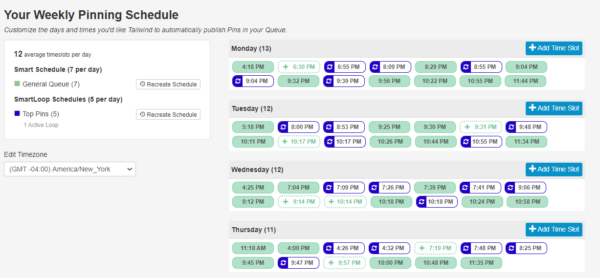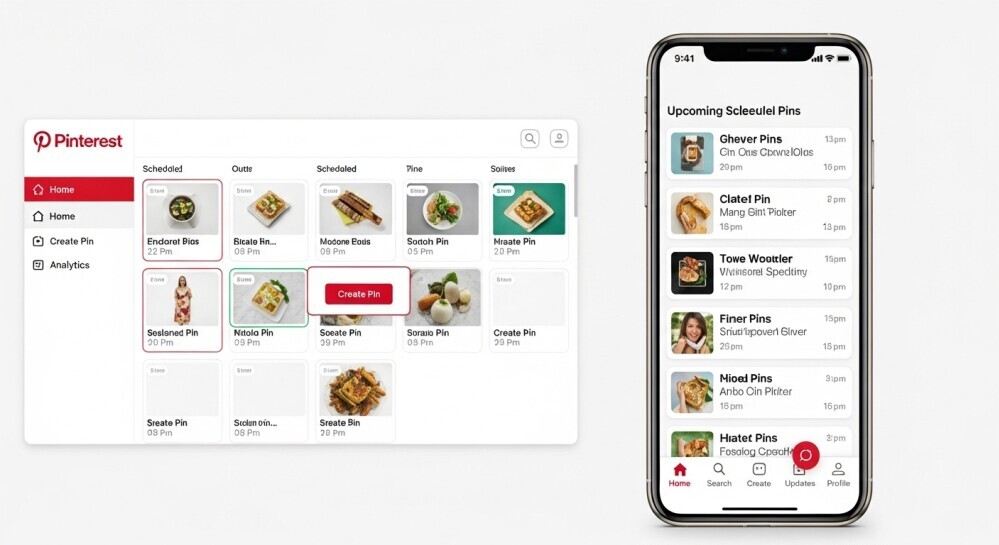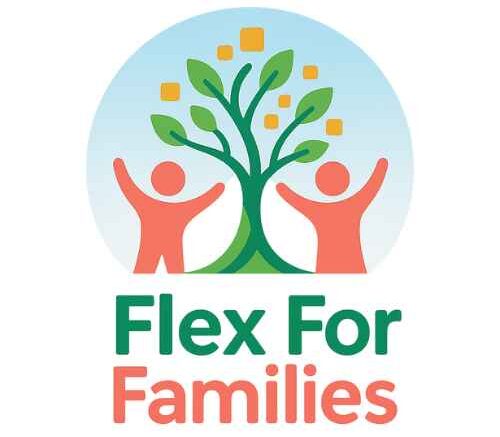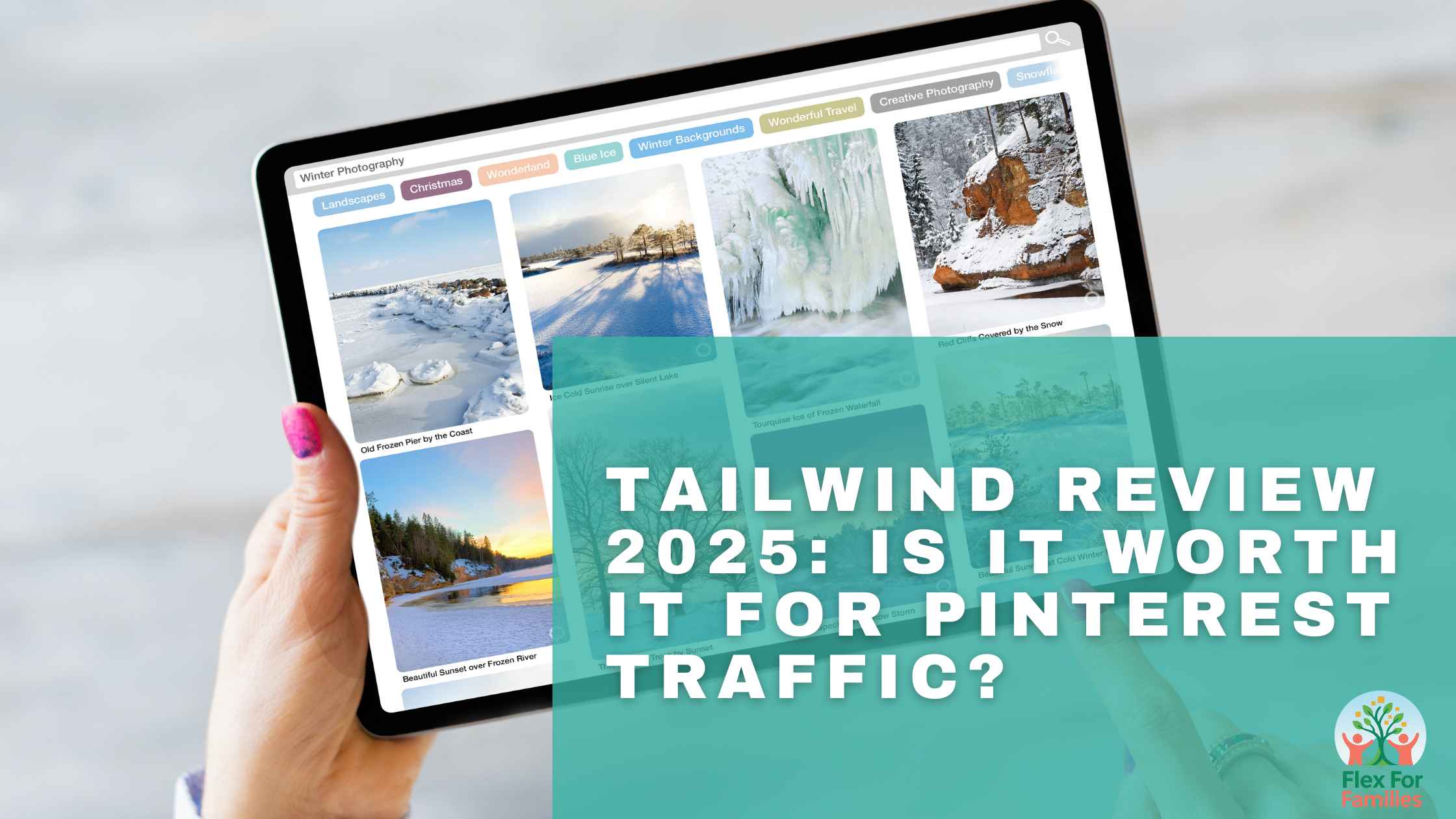If you’ve ever tried to grow blog traffic with Pinterest while juggling school runs, snack breaks, and screen-time negotiations, you already know—it’s a lot.
Pinterest can be a goldmine for parent bloggers, but keeping up with pin designs, posting schedules, and analytics can start to feel like another full-time job. That’s why tools like Tailwind get so much attention. They promise to simplify Pinterest marketing, save time, and help your blog reach more readers—without you being glued to your phone.
But is Tailwind really worth it in 2025? Or are there simpler ways to stay consistent and grow your traffic?
After using Tailwind on my own blog, I’ve tested what it actually does, how it fits into a busy parent’s routine, and whether it’s still the best tool for Pinterest in today’s algorithm.
💡 Quick Tip:
If you’re just starting out with blogging and Pinterest, grab my free Nap-Time Blogging Checklist. It’s a simple step-by-step guide for parents who want to start growing traffic—without burning out.
What Is Tailwind (and How It Works with Pinterest)

Tailwind is an official Pinterest partner designed to make your pinning easier and more effective. In simple terms, it helps you plan, schedule, and track your Pinterest posts automatically.
Instead of manually uploading pins every day (because who has time for that?), Tailwind lets you:
- Schedule Pins in advance using SmartSchedule, which posts when your audience is most active.
- Design Pins quickly using Tailwind Create — a built-in tool with templates ready for your branding.
- Join Communities (formerly called Tribes) where other bloggers share and reshare your pins for more reach.
- Use Ghostwriter AI to draft captions and descriptions faster.
- Track Analytics to see which pins perform best and what content drives the most traffic.
For parents who want to stay consistent without constant screen time, Tailwind can feel like a quiet helper working behind the scenes.
Want to see Tailwind in action? Here’s a quick video walkthrough showing how it connects with Pinterest and what the dashboard looks like.
Parent Tip: Think of Tailwind like your Pinterest autopilot—set it up once a week, and let it keep your content moving while you focus on family time.
My Experience Using Tailwind as a Parent Blogger
When I first started using Tailwind, I was in that familiar parenting-and-blogging juggling act. Between school pickups, meal prep, and trying to write during nap times, the idea of managing Pinterest manually felt impossible.

Tailwind promised to make things easier — and to be fair, it did.
The setup took me about an hour (mostly linking Pinterest, exploring features, and adjusting posting times). Once it was running, I could batch-create pins on Sunday night, load them into the scheduler, and forget about them for the rest of the week.
That alone freed up hours I’d normally spend posting pins at random times.
I also joined a few Tailwind Communities related to blogging and parenting, and while not every share drove massive traffic, a few pins gained steady traction thanks to other members resharing them.
What I appreciated most was how Tailwind helped me stay consistent. Even during busy family weeks when I couldn’t log in daily, my Pinterest stayed active — which made a noticeable difference in impressions and clicks over time.
Of course, it wasn’t perfect. Tailwind’s analytics dashboard felt a little overwhelming at first, and I had to learn what actually mattered (like repin rate and link clicks) versus what looked impressive but didn’t move the needle.
But once I found my rhythm, it became one of those quiet, reliable tools that just worked in the background — no fuss, no burnout.
Parent Tip: Set aside one evening each week to plan and schedule your pins. Tailwind does the rest, so you can spend your weekdays focusing on family—or your next blog post.
Tailwind Features (2025 Update Overview)
Tailwind has come a long way since it first launched. In 2025, the platform has added a few new features that make Pinterest management even smoother — especially for bloggers who are short on time (which, let’s be honest, is every parent blogger ever).

Here’s a quick look at what’s new and what still matters most:
1. SmartSchedule
This is the heart of Tailwind. It automatically finds the best times to post based on your audience’s activity.
Once you load your pins, Tailwind spaces them out for you — no more guessing when to post.
Parent win: You can set it once and let it run while you’re doing school runs or dinner prep.
2. Tailwind Create 2.0
This built-in design tool got a big upgrade in 2025. You can now make pin designs in minutes using ready-made templates that match your brand colours and fonts.
It’s not a full Canva replacement, but it’s handy for quick pin batches.
Parent win: No more endless design tweaks — just plug in your blog title and go.
3. Ghostwriter AI
A newer addition, Ghostwriter uses AI to write pin captions, descriptions, and even social posts. It’s a great timesaver, though the tone sometimes needs a human touch to sound like you.
Parent win: Write smarter, not longer — just proofread before posting to keep your voice authentic.
4. Communities (Formerly Tribes)
These are group boards inside Tailwind where bloggers share each other’s pins. They’re not as active as they once were, but still useful for niche collaboration (especially parenting, lifestyle, or blogging topics).
Parent win: A supportive way to connect and get your pins reshared by others in your niche.
5. Pin Inspector and Insights Dashboard
Tailwind’s updated analytics let you see which pins are driving real traffic. It can look a little overwhelming at first, but once you focus on metrics like “Top Pins” and “Repin Rate,” you’ll know where to spend your time.
Parent win: Skip the data overload — just check what’s working and do more of that.
Here’s a second video that dives into recent features and a live demo of how Tailwind’s tools like SmartSchedule and Communities, look in 2025.
Parent Tip: Don’t try to use every Tailwind feature right away. Start with SmartSchedule and Create 2.0 — master those first, then explore analytics once you’re ready to fine-tune your strategy.
Tailwind Review: Pros and Cons (2025 Edition)
Like any blogging tool, Tailwind has its strengths — and a few quirks that might not work for everyone. After using it regularly, here’s my honest take on what’s great (and what to keep in mind before upgrading).
Tailwind Review: Pros
1. Huge Time Saver
Scheduling pins in batches means you can “set it and forget it” for the week. Tailwind keeps your Pinterest active even on days when you don’t touch your laptop.
2. Smart Posting with Consistency
Tailwind’s SmartSchedule ensures your pins go out when your audience is most active, helping you stay consistent without constant effort.
3. Built-In Design Tools
Tailwind Create 2.0 makes it easy to design fresh pins without leaving the platform. It’s fast, intuitive, and great for beginners.
4. Insights That Actually Help
Once you get familiar with Tailwind’s analytics, you’ll see what’s working — and where to focus your time.
5. Supportive Communities
The “Communities” feature still helps parent bloggers find new audiences, especially in family, lifestyle, and home niches.
Tailwind Review: Cons
1. Free Plan Is Very Limited
The free version gives you just a handful of scheduled pins per month, which isn’t enough for consistent growth.
2. Learning Curve
The dashboard can feel a little technical at first. It takes a bit of time to figure out what each feature does (and what you can ignore).
3. Ghostwriter Can Sound Robotic
Tailwind’s AI captions save time, but they often need a personal touch to sound natural.
4. Some Bloggers See Better Manual Results
Depending on your niche, manual pinning or using Pinterest’s own scheduler may still outperform Tailwind’s automation — especially if you’re very hands-on.
Parent Tip: Use Tailwind for what it does best — saving time and staying consistent. Combine it with a bit of manual pinning for personal engagement, and the best of both worlds.
Tailwind Pricing (Is It Still Worth It?)
In 2025, Tailwind offers a few different plans depending on how much you post and which platforms you use. Let’s break them down in plain language, so you know what you’re really getting.
Free Plan
Tailwind’s free version lets you:
- Schedule up to 20 posts per month (Pinterest, Instagram, or both)
- Use a few Tailwind Create templates
- Access limited analytics
It’s a good way to test the platform, but you’ll outgrow it quickly if you’re using Pinterest consistently.
Pro Plan ($13–$20/month)
This plan unlocks most of what parent bloggers need, including:
- Unlimited pin scheduling
- SmartSchedule
- Full access to Tailwind Create 2.0
- Basic analytics and Communities
It’s the sweet spot for bloggers who pin a few times a day and want automation without the extra cost of bigger plans.
Advanced and Max Plans ($40–$80/month)
These are for larger content creators managing multiple accounts or teams. Most parent bloggers won’t need this level unless you’re running several blogs or helping clients with Pinterest management.
Is It Worth Paying For?
If Pinterest is a key part of your traffic strategy, yes — Tailwind can be worth it.
For around the price of a takeaway coffee each week, you can keep your Pinterest running smoothly without daily effort.
If you’re still new or pinning casually, start with the free plan to get comfortable. Then, upgrade once you’re ready to post regularly and see consistent results.
💬 Parent Example:
When I moved from the free plan to Pro, my Pinterest impressions nearly doubled within a month — not because Tailwind “hacked the algorithm,” but because it helped me stay consistent without burning out.
Parent Tip: Treat Tailwind like a time-saving helper, not a magic traffic button. The real growth comes from your content — Tailwind makes sure it gets seen more often.
Tailwind Alternatives
Tailwind is powerful, but it’s not the only way to stay consistent on Pinterest. Depending on your goals and budget, there are a few other tools that can help you manage pins and track results — some even for free.
Here are a few solid alternatives worth exploring:
1. Pinterest’s Native Scheduler (Free)

Pinterest’s built-in scheduler has improved a lot over the past couple of years. It now lets you schedule up to 30 pins up to two weeks in advance — perfect for parent bloggers who want a simple, no-cost option.
When it works best:
If you’re pinning casually or just starting out, this tool keeps things easy without extra logins or subscriptions.
Downside:
You can’t post across multiple accounts or utilise advanced analytics, such as those offered by Tailwind.
2. Canva’s Content Planner

If you have already designed your pins in Canva, their built-in scheduler might be enough. It lets you design and schedule directly from one dashboard — a huge time saver if visuals are your focus.
When it works best:
For visual-first bloggers who create all their graphics in Canva and only need light automation.
Downside:
It lacks analytics and bulk-scheduling options, so you’ll still need to check Pinterest performance separately.
3. Metricool

Metricool is another handy option that covers multiple platforms — Pinterest, Instagram, Facebook, and even your blog. It’s great if you want to manage all your social content in one place.
When it works best:
For parent bloggers ready to organise all social posting (not just Pinterest) from a single tool.
Downside:
The Pinterest features aren’t as advanced as Tailwind’s, so it may not be ideal for traffic-focused Pinterest strategies.
4. Manual Pinning (The Classic Way)
Some bloggers still prefer to pin manually — especially if they love engaging directly with Pinterest trends or group boards.
When it works best:
If you enjoy hands-on posting or want full control over your pin timing and engagement.
Downside:
It’s time-consuming. Most parents find it hard to stay consistent with manual pinning long-term.
Parent Tip: Try starting with Pinterest’s free scheduler first. Once you find your rhythm, upgrade to Tailwind for automation and better analytics when you’re ready to grow faster.
Verdict: Is Tailwind Worth It for Pinterest Traffic in 2025?
For parent bloggers who rely on Pinterest as a major traffic source, Tailwind still earns its place in 2025. It’s not a magic traffic button — but it is a reliable helper that keeps your blog visible even when family life gets chaotic.
The biggest benefit? Consistency without burnout.
When you can schedule a week’s worth of pins during nap time and still spend your evenings offline, that’s real balance.
Tailwind’s automation, templates, and analytics help you stay organised and focused on what matters most — creating content your audience loves.
If you’re ready to take Pinterest seriously but need a tool that fits a parent-friendly schedule, Tailwind is absolutely worth testing.
Start with the free plan, see how it fits your workflow, and upgrade only if it truly saves you time.
Next Step: Want to learn how to use tools like Tailwind as part of a real blogging strategy? Read my Wealthy Affiliate Review 2025 to see how busy parents are growing traffic—and income—without falling for hype.
💬 Let’s Chat!
Pinterest can be such a powerful tool for growing your blog — but figuring out how to use it without losing hours in the process? That’s the real challenge.
I’d love to know: have you tried Tailwind, or are you still pinning manually? What’s worked best for keeping your Pinterest active while managing family life?
Drop your thoughts in the comments below — your routine, your results, even your frustrations. Your story might be exactly what another parent blogger needs to read today.





I’ve been up in the air about adding Pinterest to my stable of Social Media accounts. Tailwind seems to add another layer to it. I definitely don’t want to be Pinning all day, Ha, Ha. You’ve really made me think about how this can help me move forward with my business by incorporating Tailwind.
Your clear and precise review is a BIG help. You’ve saved me a lot of research time and John, it is much appreciated.
Thanks so much — I really appreciate that! I completely get where you’re coming from. Pinterest can feel like a whole new world at first, and the idea of “Pinning all day” is exactly what I wanted to avoid too! That’s honestly where Tailwind makes all the difference — it lets you stay consistent without being constantly online.
What I love most is how it helps you batch and schedule everything in one go, so you can focus on creating great content instead of managing endless Pins. Once it’s set up, it pretty much runs quietly in the background while still driving steady traffic.
I’m glad the review helped clarify things — and if you do decide to give Pinterest a try, Tailwind’s SmartLoop and analytics tools are great starting points. Out of curiosity, what kind of business or content are you planning to promote on Pinterest?
John
This was a solid and practical review, John. I’ve used Tailwind before, though not as consistently as I should have. It really does take the pressure off when life gets busy. I’m curious, though, do you think Tailwind’s Communities are still as effective in 2025, or have most bloggers shifted toward group boards and collaborations instead? Where I come from, we say, sticks in a bundle are unbreakable. Collaboration still feels like the heart of growth.
John
Hey John,
Thanks so much — I really appreciate that! You’re absolutely right, Tailwind shines most when life gets hectic. Once it’s set up, it quietly keeps your content moving, even when you can’t be everywhere at once.
I love that saying — “sticks in a bundle are unbreakable.” It captures the spirit of collaboration perfectly. In 2025, I’d say Tailwind Communities are still valuable, especially for niche-specific sharing and steady traffic, but their impact depends on how active the members are. Some Communities thrive, while others have slowed down.
More bloggers are definitely combining them with group boards, collab Pins, and even content swaps through Facebook or Slack groups. The real growth still comes from connecting with others — whether that’s inside Tailwind or through your own network of like-minded creators.
Out of curiosity, have you found a particular type of collaboration that’s worked best for your content — Communities, group boards, or partnerships?
John